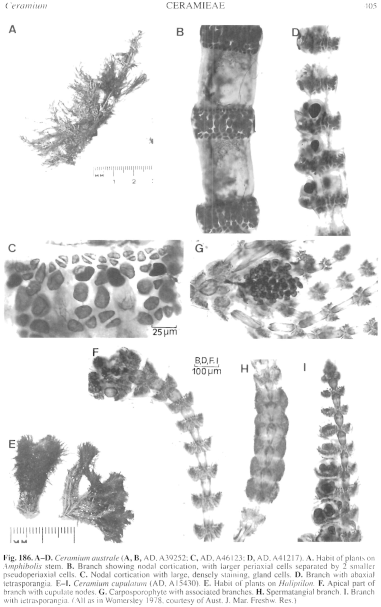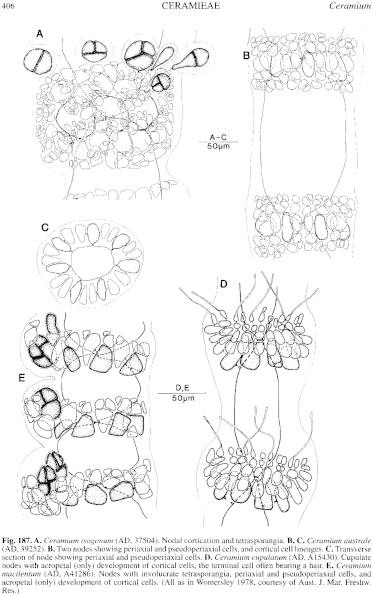|
|
|
|
|
|||||||||||
|
Electronic Flora of South Australia Species Fact Sheet
Phylum Rhodophyta – Order Ceramiales – Family Ceramiaceae – Tribe Ceramieae
Selected citations: Silva et al. 1996: 393.
Synonym
C. repens Harvey 1863, synop.: xlviii. J. Agardh 1876: 92. De Toni 1903: 1446. Lucas 1909: 52. Lucas & Perrin 1947: 365. Sonder 1881: 12. (NON C. repens (Dillwyn) C. Agardh 1817: 63 = Spermothamnion turneri, or C. repens Zanardini 1847: 221 = C. rubrum?)
Thallus (Fig. 186E) red, 0.5–1 cm high, forming a dense cover on Haliptilon, with extensive prostrate filaments. Erect filaments numerous, arising from most nodes of the prostrate filaments, simple or usually with several subdichotomous to lateral branches; nodes, especially in erect filaments, cupulate in form due to acropetal development only of cortical cells. Attachment by one to several clumped rhizoids arising from the periaxial cells on the underside of the prostrate filaments; rhizoids single or often densely grouped, usually unicellular plus the multicellular pad of one or a group of rhizoids; epiphytic on Haliptilon. Structure. Branches 75–200 in diameter (at nodes), fairly uniform in diameter to just below the erect or involute, usually tapering, apices (Fig. 186F, I). Axial cells isodiametric near apices, elongating to L/D 2–4 below, with prominent nodal bands 35–80 µm long and internodal spaces about as long as the nodes near apices (Fig. 186F), elongating to 2–4 times as long below. Periaxial cells 6–8, each cutting off two cells acropetally (Fig. 187D) with continued divisions into one or two cells (progressively smaller) to give a node 4–5 cells long in upper parts, 6–7 cells long below; usually no basipetal cells are cut off by the periaxial cells (Figs 186F, 187D), and no outer cortical cells are formed, but in A19591 some of the periaxial cells in older nodes cut off single cells laterally (partly in the periaxial ring) or just basipetally; slender hairs are produced by many of the terminal cortical cells of each node. Rhodoplasts discoid in small cells becoming ribbon like in larger cells.
Reproduction: Gametophytes dioecious. Carposporophytes (Fig. 186G) borne part way up the erect branches, surrounded by 3–7 slightly curved to straight laterals (often relatively long) which arise from periaxial cells of the axial cell bearing the carposporophyte; carposporophytes globular, 200–350 µm across, carposporangia subspherical to ovoid, 20–30 µm in diameter. Spermatangia (Fig. 186H) covering nodes of erect branches, produced from all cortical cells of a node.
Tetrasporangia (Fig. 186I) at first unilateral but becoming verticillate on upper parts of erect branches, prominent, with several produced successively from each node from the periaxial cells, with the lower third to half of the tetrasporangia involucrate by cortical filaments; these filaments usually showing 2–3 more divisions than the other nodal cortical filaments, which are often only 3–4 cells long; tetrasporangia with prominent persistent sheaths, subspherical, 35–60 µm in diameter, decussately divided.
Type from D'Estrees Bay, Kangaroo I., S. Aust., on Haliptilon roseum in pools at reef edge (Womersley, 24.viii.1950); holotype AD, A15430, isotypes also under this number.
Distribution: Only known from the type locality; from Point Sinclair, S. Aust., lower eulittoral on crustose corallines (Womersley, 7.ii.1954; AD, A19591); and from Port Phillip, Vic., on Corallina? (Mueller), type of C. repens Harvey (holotype in TCD).
Taxonomic notes: C. repens Harvey was recorded from Diego Garcia, Mahe, by Reinbold (1907, p. 576), but it seems unlikely that this record applies to the southern Australian species. C. cupulatum is a distinctive species, characterised by its small size, epiphytic habit on Haliptilon, and especially by the cupulate nodes produced by the spreading, acropetal development from the periaxial cells. The commonly clumped rhizoids are similar to those of C. filiculum.
References:
AGARDH, C.A. (1817). Synopsis Algarum Scandinaviae. (Berling: Lund.)
AGARDH, J.G. (1876). Species Genera et Ordines Algarum. Vol. 3, Part 1- Epicrisis systematic Floridearum, pp. i-vii, 1–724. (Weigel: Leipzig.)
DE TONI, G.B. (1903). Sylloge Algarum omnium hucusque Cognitarum. Vol. 4. Florideae. Sect. 3, pp. 775–1521 + 1523–1525. (Padua.)
HARVEY, W.H. (1863). Phycologia Australica. Vol. 5, Plates 241–300, synop., pp. i-lxxiii. (Reeve: London.)
LUCAS, A.H.S. & PERRIN, F. (1947). The Seaweeds of South Australia. Part 2. The Red Seaweeds. (Govt Printer: Adelaide.)
LUCAS, A.H.S. (1909). Revised list of the Fucoideae and Florideae of Australia. Proc. Linn. Soc. N.S.W. 34, 9–60.
REINBOLD, T. (1907). Die Meeresalgen der deutschen Tiefsee Expedition 1898–1899. Wiss. Ergebn. dt. Tiefsee-Exped. auf dem Dampfer "Valdivia", 1898–1899, Vol. 2, Part 2, pp. 549–586, Plates LV-LVIII.
SILVA, P.C., BASSON, P.W. & MOE, R.L. (1996). Catalogue of the Benthic Marine Algae of the Indian Ocean. (University of California Press: Berkeley, Los Angeles & London.)
SONDER, O.W. (1881). In Mueller, F., Fragmenta Phytographiae Australiae. Supplementum ad volumen undecinum: Algae Australianae hactenus cognitae, pp. 1–42, 105–107. (Melbourne.)
WOMERSLEY, H.B.S. (1978). Southern Australian species of Ceramium Roth (Rhodophyta). Aust. J. Mar. Freshw. Res. 29, 205–257.
ZANARDINI, G. (1847). Notizie intorno alle cellulari marine delle lagune e de' littorali di Venezia (1). Mem. R. Inst. Veneto Sci. Lett. Art. 6, 185–262.
The Marine Benthic Flora of Southern Australia Part IIIC complete list of references.
Publication:
Womersley, H.B.S. (24 December, 1998)
The Marine Benthic Flora of Southern Australia
Rhodophyta. Part IIIC. Ceramiales – Ceramiaceae, Dasyaceae
©State Herbarium of South Australia, Government of South Australia
Illustrations in Womersley Part IIIA, 1998: FIGS 186 E–I, 187D.

Figure 186 enlarge
Fig. 186. A–D. Ceramium australe (A, B, AD, A39252; C, AD, A46123; D, AD, A41217). A. Habit of plants on Amphibolis stem. B. Branch showing nodal cortication, with larger periaxial cells separated by 2 smaller pseudoperiaxial cells. C. Nodal cortication with large, densely staining, gland cells. D. Branch with abaxial tetrasporangia. E–I. Ceramium cupulatum (AD, A 15430). E. Habit of plants on Haliptilon. F. Apical part of branch with cupulate nodes. G. Carposporophyte with associated branches. H. Spermatangial branch. I. Branch with tetrasporangia. (All as in Womersley 1978, courtesy of Aust. J. Mar. Freshw. Res.)

Figure 187 enlarge
Fig. 187. A. Ceramium isogonum (AD, 37504). Nodal cortication and tetrasporangia. B, C. Ceramium australe (AD, 39252). B. Two nodes showing periaxial and pseudoperiaxial cells, and cortical cell lineages. C. Transverse section of node showing periaxial and pseudoperiaxial cells. D. Ceramium cupulatum (AD, A15430). Cupulate nodes with acropetal (only) development of cortical cells, the terminal cell often bearing a hair. E. Ceramium macilentum (AD, A41286). Nodes with involucrate tetrasporangia, periaxial and pseudoperiaxial cells, and acropetal (only) development of cortical cells. (All as in Womersley 1978, courtesy of Aust. J. Mar. Freshw. Res.)

|
Email Contact: State Herbarium of South Australia |

|